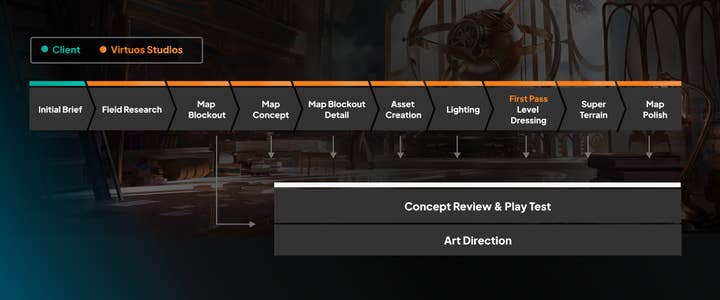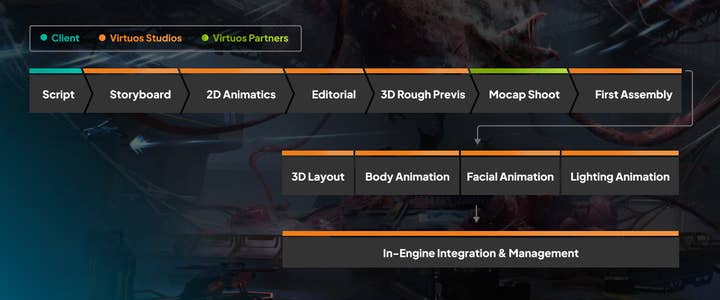Making games faster, more cost-effectively, with end-to-end development
Development experts Virtuos on the opportunities offered by end-to-end development services
Game development is no longer just a one-man show – or even a one-studio spectacle. The seismic size of games these days means that the crafting of fantastical, virtual realms is easily a multi-team endeavour.
Fortunately, developers can turn to partners, such as external developers, to realise their most ambitious projects. One rapidly growing model is external development, which sees a studio turn to one or more companies to assist with game creation. In particular, a specific flavour of external development is end-to-end development, which sees an external company oversee an entire segment of a project.
“End-to-end is, in a nutshell, when an external developer takes on a large portion, or the whole pipeline, of the game development process,” says Mike Sherak, Virtuos’ assistant director of co-development success. “This can include concept, model, rigging, animation, VFX, lighting, character animation delivered in-engine, and more.”
A key advantage of end-to-end development is the ease of working with just one partner, rather than managing multiple vendors. Not only can this ease cross-team collaboration, but it also allows teams to share their learnings at every stage of the project. In this way, development can take place faster, and games can be made better.
Sherak believes end-to-end development also encourages developers to be more creative. "It’s more fun for the artists because they get a greater sense of ownership over the project, which drives them to be more proactive when generating new, exciting ideas — something that’s always good to have,” he says. “With an experienced external developer like Virtuos, studios can freely offer their feedback, and be assured that these would be communicated and implemented during development, rather than sharing this across, say ten vendors on their own, or hire more people to manage this process.”
Another advantage is the efficiencies end-to-end development can unlock. When done right, this can minimize developers’ already scarce resources, resulting in a greater return on investment and improved results from reduced lead time and costs. For instance, developers need not go through the hassle of approving work at every stage. Rather than pause development for an asset or concept art that’s pending approval, liaising with a single external developer can greatly streamline the approval process.
“Studios that work with a trusted external developer can rely on them for quality management, such that there’s a consistent level of development quality across the teams working on the project. This minimizes any time wasted on waiting for approvals for any tasks,” Sherak says.
"End-to-end development can save up to 35% to 80% of external production costs, reducing production time between 10% to 70%"
As a result, developers can re-invest these resources on enhancing the gaming experience. According to Virtuos, end-to-end development can save up to 35 to 80% of external production costs, reducing production time between 10% to 70%.
Such an approach has helped one of Virtuos’ clients reduce production time and budget on the development of an MMORPG. Virtuos assigned their studios in Xi’an and Chengdu, from China, to offer additional support on artwork. As the company need not go through repetitive rounds of approvals, this saw the developer shaving significant time and costs off the development process. And with these newfound resources, the company could even task Virtuos with more levels to produce, so it can focus on other aspects of development.
But rather than just diving straight into the deep end of end-to-end development, engaging an external developer on a small, specific part of the project is a good initial step. By dipping their toes into the water, this can help developers better understand the entire process. The more they understand how external development functions, the easier it is to hand over a heftier chunk of game development to a trusted partner.
“This should be carried out in a careful, methodical approach, rather than just handing over a team of 15 or 20 people and expecting developers to figure the process out on their own,” Sherak says.
Likewise, an experienced external developer can adapt its capabilities to their clients’ evolving demands, the further down they are into the development process. A developer may initially request for support with character modelling, but this can be extended to other aspects of character art, with the company even delegating the full pipeline of rigging and animation to their partner. Eventually, the external developer may be brought onto future projects at a much earlier stage.
Sherak points out that companies are increasingly engaging Virtuos at a much earlier stage of development as they become more familiar with their services. “At the end of the day, developers just want us to help them discover the most efficient way of making their games,” he adds.
One 50-people-strong team at Virtuos has produced and delivered 15 in-engine open-world maps for a particular game. The team eventually took the lead for concept, grey box, layout, level art and lighting, with the developer handing more responsibilities to the team as their partnership deepened.

In addition, Virtuos has partnered with Riot Games, in which a team of 30 artists worked on art briefing, concept, 2D Animatic, 3D art, 3D modelling, rigging, animation and VFX for the studio. To date, the team has helped develop over 100 skins for League of Legends – the very game that has put Riot Games on the map.

End-to-end development also played a huge role in the successes of one of 2023's most acclaimed games: Marvel’s Midnight Suns by Firaxis Games. Virtuos contributed to the high-fidelity cinematics and cutscenes — 108 minutes in all — for Midnight Suns, with the external developer offering support in storyboarding, 2D Animatics, 3D Previs, 3D Layout, body and facial animation, rigging, and animation lighting. All these were delivered directly into Firaxis Games’ proprietary engine.

Of course, end-to-end development isn’t the only development model. Depending on your requirements, studios can also look to distributed development, where a company looks to a single partner or multiple providers — those with a global network of studios — to manage the various facets of game development.
The benefits that developers can reap from external, end-to-end development are numerous, particularly with an external company taking on considerable aspects of a project. The result is that developers can concentrate on realising their vision for their games to the fullest. If you wish to discuss your game development needs with Virtuos, email partner_relations@virtuosgames.com.
